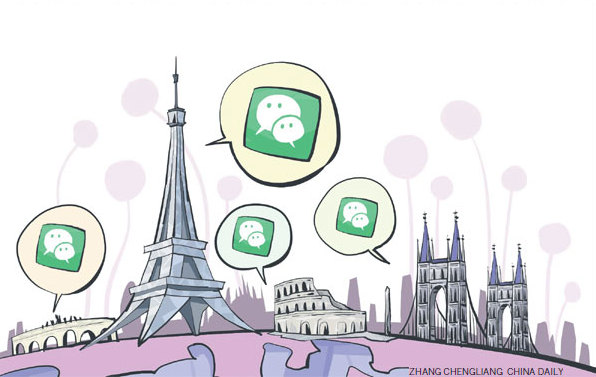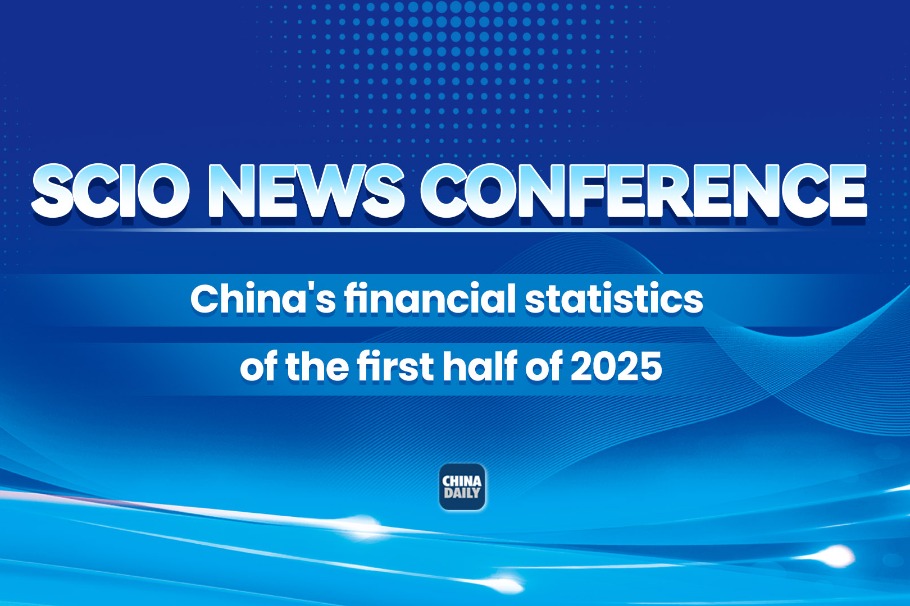WeChat could mushroom in Europe

Companies should take notice of the brand image that the social media giant has achieved outside China
WeChat, launched by Chinese high-tech giant Tencent six years ago, has come to dominate the social media scene in China and increasingly outside the country.
A staggering 963 million active monthly users, inside and outside China, are now part of the WeChat community.
But few European internet and social media heavy consumers, and fewer still European companies, are aware of the extent to which WeChat has become such an entrenched part of everyday life for its loyal Chinese consumer base of almost 1 billion.

European companies and consumers are probably unaware of the 80 percent penetration that WeChat has achieved across China, leaving the competition trailing in its wake. Second behind social market application leader WeChat in China is QQ, also owned by Tencent, but with a paltry penetration rate of 49 percent, and Sina Weibo comes in third with a miserable and meager penetration rate of 7.5 percent.
European companies and consumers need to become far more familiar with the vast and increasing range of services that WeChat now provides, which goes some way to explaining its popularity.
Of course, the WeChat platform, which also offers services in English as well as Chinese, allows users to chat and exchange messages with friends and colleagues, but it goes much further. People also regularly use WeChat to call, to purchase goods and services with QR codes, to search and order goods and services online (including reserving a restaurant table) and to play games online and read and share news. WeChat can also be used to settle the bill at a restaurant and to hail a taxi.
If WeChat's massive market penetration level in China, and in particular the gap between the market leader and the market number two, is not enough to rouse the attention, admiration and potential partnership opportunities that Tencent's flagship brand fully deserves, then European companies and consumers should take note of the recent announcement by global mobile phone giant Apple.
A few weeks ago, the behemoth US brand issued a statement announcing that its Chinese mainland users will now be able to make use of WeChat's payment service, WeChat Pay, for purchases made on the App Store and for Apple Music products, too.
Aware of the attractiveness of this announcement, Apple has sought to maximize security as well as efficiency of the service by allowing users to use fingerprints to confirm their identify, and no password will be necessary.
Finally, European companies should note the brand image that WeChat appears to have achieved with an increasing number outside China. "Innovative", "user friendly", "efficient" and "functionally superior" are examples of impressions in the minds of many European and US heavy social media users.

European and Western brands should not, therefore, continue to remain distant and prevaricate but should jump on the WeChat bandwagon immediately.
However, this WeChat ignorance may soon be over, with WeChat now set on expansion and penetration across Europe. In fact, it arrived in mainland Europe back in 2015, setting up an office in the Italian fashion capital of Milan.
During 2017, WeChat has been making significant progress in building European brand awareness and penetration, targeting Paris and London in particular.
Rapid and lasting European penetration should come as no surprise, and European businesses need to take full advantage.
When placed alongside the best known Western equivalents, such as Facebook Messenger, WhatsApp or Twitter, WeChat reigns supreme, with a vastly superior range of services.
It has also established a reputation for innovation and creativity, with various initiatives that have led to spectacular and immediate market success.
One such initiative that many argue should be seen as a defining moment in WeChat's global rise was the launch of an electronic version of the traditional cash gift sent to family and friends in a red envelope (hongbao) at the time of the Chinese New Year (easily the most important and respected festival of the year). This digital transaction via WeChat has captured the nation, and an incredible 500 million WeChat users made use of this service during the Chinese New Year period in February this year.
Innovation has also been accompanied by simplicity and ease of use, with an increasing number of Western consumers ditching Facebook and even Linkedin in favor of WeChat.
The competition, Facebook among them, appear to have little or no answer to WeChat's inevitable and inexorable European market rollout. Facebook's knee-jerk and panicky billion-dollar takeover of WhatsApp in 2014 could represent an example of the market dominance and respect that WeChat has earned.
In spite of the WhatsApp takeover, Facebook still does not offer the finance and payment services that WeChat provides.
WeChat's European market posturing should be seen as a huge opportunity for European brands in all sectors. WeChat's selling proposition is not only its superior functionality, efficiency and ease of use, but it also has proclaimed its intention to act as a gateway for European companies as they attempt to further penetrate the Chinese mainland market.
WeChat offers an extremely affordable and efficient online presence for brands wishing to sell more in China and to Chinese consumers around the world, and there is no need to obtain and pay for a Chinese business license. A Chinese business partner is also not needed before establishing an online presence via WeChat.
And it is not only access to the massive Chinese mainland market where WeChat can effectively and relatively cheaply unlock the door for many European brands, especially luxury fashion brands.
WeChat can also allow European companies an insight into the timing of European travel. Chinese tourists are easily the biggest spenders in the world, responsible for around 40 percent of the global luxury market, where 80 percent make their purchases overseas.
Furthermore, WeChat allows European-based retailers and producers to segment and target Chinese shoppers clearly, with the availability of both demographic and economic data such as age, gender, purchasing power and geographic location. WeChat then allows for customized and personalized messages to be sent to groups within a particularly attractive target market segment. Once tourists are traveling, WeChat also allows companies to send a variety of promotional offers and even coupons as part of a price or volume discount incentive.
If further momentum is needed as WeChat's European market penetration plan rolls out, it could come in the form of the EU-China Year of Tourism 2018. Set for launch in January 2018 in Venice, this initiative should lead to a sizeable increase in tourism to Europe from China. A number of public celebrations are planned throughout 2018, which should boost tourism revenue even further. But only those European companies that embrace WeChat and its entire range of services are likely to benefit most.
WeChat's increasingly international brand image should also attract more European companies, and urgently. Even European luxury brands could benefit, not just from the range of services provided by WeChat, but also from the association with the high quality, premium social media brand that is WeChat.
The author is a visiting professor at the University of International Business and Economics in Beijing and a senior lecturer at Southampton University. The views do not necessarily reflect those of China Daily.
(China Daily European Weekly 10/13/2017 page10)
Today's Top News
- Xi addresses Central Urban Work Conference, listing priorities for urban development
- China reports 5.3% GDP growth in H1
- China handles 95 billion parcels in first half of year
- China, India vow to boost relationship
- Tips for expats to strike swifter friendships
- Digital initiative turns city into innovation hub






























